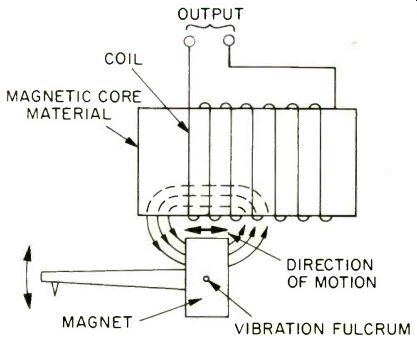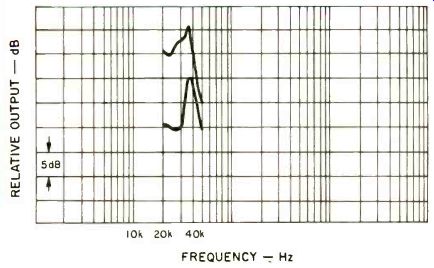
Manufacturer's Specifications
Type: Moving Flux.
Output Voltage: 3.5 mV at 1 kHz, 5 cm/S.
Channel Balance: Within 1 dB or less at 1 kHz.
Frequency Response: 10 to 40,000 Hz; 10 to 20,000 Hz ± 1 dB.
Channel Separation: 25 dB or more at 1 kHz.
Inductance: 90 mH.
Static Compliance: 50 x10^-6 cm/dyne.
Tracking Force: 1.25 grams ± 0.25.
Load Impedance: 47 kilohms at 100 pF.
Stylus Tip: Parabolic (Shibata shape).
Replacement Stylus: N1725-Qd (Black).
Price: $267.50.
The 50-year-old Astatic Corp. is known throughout the world as a pioneer in the manufacture of OEM phono cartridges and, in particular, replacement styli. It's hard to believe that 50 years have gone by since this reviewer first used an Astatic replacement stylus--time doth march on! At any rate, with today's trend towards various magnetic phono cartridge designs, rather than ceramic types, Astatic has developed the recently patented Moving Flux principle for their new line of magnetic phono cartridges.
When asked to review this cartridge, the first question was, what in the world is a Moving Flux magnetic cartridge? Careful reading of the United States patent covering this new magnetic principle supplied the answer.
Moving Flux phono cartridges apparently incorporate all the advantages of both moving-coil and moving-magnet cartridges without the usual disadvantages. Specifically, this means achieving the linearity of the conversion system used in the moving-coil cartridge, which converts the mechanical signals into electrical signals, along with the high output efficiency of the moving-magnet cartridge's vibration system, which is composed simply of the magnet and cantilever.
The principle of the Moving Flux cartridge's generation of a signal voltage is shown in Fig. 1, with one channel illustrated. Note that a coil is wound around a magnetically permeable core material and that the coil is placed in close proximity to a magnet which is attached to the stylus cantilever.
When motion from the record groove is transmitted by the cantilever to the magnet, the magnet undergoes clockwise and counterclockwise motion. However, the center of the flux generated by the magnet moves along the coil, aided by the core material's permeability, and the voltage induced in the coil remains essentially linear. High efficiency is achieved because the magnet's lines of flux cut the coil at 90 degrees.
After reading all the patent claims for the Moving Flux principle, we wondered if the phono cartridge really worked and was as good as claimed. The answer is a resounding "yes" to both queries.

Fig. 1--Layout of major components used in Moving Flux cartridges, one channel
shown.
The MF-100 has its Shibata-type parabolic diamond stylus mounted directly to what appears to be an aluminum cantilever. This stylus shape is claimed to provide a stylus-groove contact area four times greater than an elliptical or conical tip. A transparent plastic flip-down stylus guard is located on the front of the cartridge, which comes with a screwdriver, mounting screws, stylus brush, and instructions in a simple plastic case enclosed in a plain black cardboard box. The stylus is user replaceable and is a high-compliance type. Be cause the cartridge body hides the stylus when viewed from the usual top-front angle, cueing can be a bit difficult. It would have been helpful if the manufacturer had incorporated a more highly visible vertical index mark on the front of the cartridge, in line with the stylus, for use in cueing.
Measurements
 .
.
Fig. 2--Frequency response and separation using B&K's QS-2009.
 .
.
Fig. 3--Frequency response and separation using JVC's TRS-1005.
 .
.
Fig. 4--Response to a 1-kHz square wave from CBS STR-112.
The Astatic MF-100 was mounted in an Audio-Technica AT-S headshell in the Technics EPA-100 tonearm mounted on a Technics SP-10 Mk II turntable. The cartridge was oriented in the headshell and tonearm with the Dennesen Geometric Soundtracktor. Laboratory tests were conducted at an ambient temperature of 76° F. ±1° (24.4° C) and a relative humidity of 64 percent ± 3 percent. The tracking force for all reported tests was at 1.25 grams, with an anti-skating force of 1.6 grams. A cartridge load of 47 kilohms and 100 pF capacitance was used for all tests; the cartridge did not appear to be capacitance sensitive. As is our practice, measurements are made on both channels, but only the left channel is reported unless there is a significant difference between the two channels, in which case both channels are reported for a given measurement.
Frequency response, using the B&K QR-2009 and the JVC TRS-1005 test records, is ±1 dB from 20 Hz to 7 kHz, +1.5 dB at 10 kHz, +3.5 dB at 15 kHz, +6 dB at 18 kHz, and +1 dB at 20 kHz. In the high-frequency region the response is +2.5 dB at 30 kHz, +7.5 dB at 39 kHz, +2 dB at 40 kHz, and-10 dB at 50 kHz. Separation is 25 dB at 1 kHz, 25.5 dB at 10 kHz, 22 dB at 15 kHz, 23 dB at 20 kHz, 18.5 dB at 30 kHz, 6 dB at 40 kHz, and 5.5 dB at 50 kHz--all truly remarkable. From these data, it is evident that the MF-100 has an excellent frequency response and a most satisfactory high-frequency separation.
The 1-kHz square-wave response shows quite a large over shoot, almost to the full amplitude of the square wave, followed by ringing that decayed rapidly. This is probably due to a relatively undamped stylus resonance at about 34 kHz.
The cartridge-arm low-frequency lateral resonance is at about 9 Hz and the vertical resonance is at about 10 Hz, both measured with the Technics EPA-100 tonearm.
The following test records were used in making the reported measurements: Shure TTR-103, TTR-109, TTR-110, and TTR-115; Columbia STR-100 and STR-112; B&K QR-2009; JVC TRS-1005; Deutsches Hi-Fi No. 2; Nippon Columbia Audio Technical Record (PCM) XG-7002, and Ortofon Direct-Cut Pickup Test Record 0001.
Wt., 5.34 g; d.c. res., 1688 ohms; ind., 111.6 mH; tracking force, 1.25 g; anti-skating force, 1.6 g; output, 1.02 mV/cm/S; IM distortion (4:1): +9 dB lateral, 200/4000 Hz, 1.8 percent; +6 dB vertical, 200/4000 Hz, 4.8 percent; crosstalk (using Shure TTR-109), 28 dB; channel balance, 0.5 dB; trackability: high freq. (10.8 kHz pulsed), 30 cm/S, mid-freq. (1000 + 1500 Hz, lat. cut), 31.5 cm/S, low freq. (400 + 4000 Hz, lat. cut), 30 cm/S; Deutsches Hi-Fi No. 2 300-Hz test band was tracked cleanly to 77 microns (0.0077 cm), lateral at 14.5 cm/S at a level of +8.70 dB, and 43.1 microns (0.00431 cm) vertical at 8.12 cm/S and a level of +3.64 dB.
The Astatic MF-100 played all the test bands except for level 5 of the violin, where some distortion was evident, on the Shure Obstacle Course--Era Ill. On the Shure Obstacle Course--Era IV, the cartridge passed all test bands without a problem except for the harp test band level 5, where just a hint of mistracking was heard. This constitutes very good performance.
==============
Evaluation Equipment and Records
The following equipment was utilized in the listening evaluation of the Astatic MF-100 phono cartridge:
Technics SP-10 Mk II turntable, Technics EPA-100 tonearm, Nikko Beta 1 preamplifier, Crown IC-150A preamplifier, Audionics of Oregon Space and Image Composer, Audire DM-700 power amplifier, Audio Innovations LED 2C Dynamic Power Display, and a pair of stacked Duntech DL-15B speakers in each channel. Each pair of speakers was connected to the Audire DM-700 power amplifier with Monster Cable. The turntable was equipped with the Hiraoka Disk-SE 22 turntable mat.
The following records were among those used to aurally assess the performance of the Astatic MF-100 cartridge:
Stereo
Supertramp, Crime of he Century--Mobile Fidelity Sound Lab. MFSL1-005.
John Williams: Close Encounters of the Third Kind, Mehta, Los Angeles Philharmonic Orchestra--Mobile Fidelity Sound Lab. MFSL1-008.
Mahler: Symphony No. 4, Karajan, Berliner Philharmoniker--Deutsches Grammophon 2531 205.
Virtuose Kammermusik, Wolfgang Schulz, Querflote-Telefunken 6.42364AP.
Bach: Die Dreifaltigke'tsorgel zu Ottoburen, Ton Koopman, organ--Telefunk en 6.35375DX.
Indianapolis Symphony Orchestra, Fifty Colorful Years- RCA DPL2-0432.
Parnassus Ensemble- Accent Acc 7806.
Kabi Laretei, piano, Close-ups, the film music of Ingmar Bergman--Proprius Prop 7829.
Mozart: Requiem, The Stockholm St. Jacob Choir, Stefan Skold--Proprius Prop 7815.
Pavarotti, O Sole Mio, Favorite Neapolitan Songs-- London OS 26560.
Mendelssohn: Symphonien No. 4 & 5, Bernstein, Israel Philharmonic Orchestra
- Deutsches Grammophon 2531 097.
Handel: Organ Concertos, George Malcolm, organ--Argo ZRG 888.
Direct to Disc
Space Organ, Jonas Nordwall, organ--Crystal Clear Records CCS 6003.
Laurindo Almeida, New Directions- Crystal Clear Records CCS 8007.
Blockbuster- East World (Toshiba-EMI) EWLF-98002.
Naima- East World (Toshiba-EMI) EWLF-98004.
Montgomery and Lytle, Ragtime Piano for Four Hands- Sonic Arts Laboratory Series No. 6.
Woofers, Tweeters and All That Jazz (binaural)--Sonic Arts Laboratory Series No. 7.
Beethoven: Piano Sonata No. 23 in F Major, Op. 57 "Appassionata," I. Kamiya, pianist playing the Bosendorfer Imperial piano--RCA (Japan) RDC-4.
Vivaldi: Four Seasons, M. Hayakawa, Vivaldi Ensemble, Tokyo--RCA ( Japan) RDCE-501-2.
New Baby, Randi and Quest--Sheffield Lab. 12.
Introducing Bosendorfer (Imperial) and Kimball (Professional): The State of the Art in Recording Pianos--Kimball Piano & Organ Co., Jasper, Ind. 47546.
Pulse Code Modulation (PCM) Digital to Analog
The Tip of the Weisberg--Nautilus NR 7.
John Williams Works--Denon SX-7006.
Digital Spectacular, Stanley Black, His Piano and Orchestra--London LDP 30001.
Mozart: Symphony No. 38 in D Major "Prague" and Symphony No. 36 in C Major "Linz," Suitner, NHK Symphony Orchestra--Denon OX-7156-ND.
Famous Classical Music on Screen--Denon OX 7146-ND.
Beloved Screen Music--Denon SX-7008.
Screen Music for Lovers--Denon SX-7007.
Schubert: Sonata in A Minor for Arpeggione and Piano; Vieuxtemp: Sonata in B-flat Major for Viola and Piano- Denon OX-7154-ND.
Proprius and Accent records are distributed by AudioSource, 1185 Chess Drive, Suite G, Foster City, Calif. 94404.
East World (Toshiba-EMI), Sonic Arts Corp., and RCA ( Japan) direct-to-disc records are distributed by Audio-Technica, 1221 Commerce Drive, Stow, Ohio 44224.
Denon records are distributed by American Audioport, Inc., 1407 N. Providence Rd., Columbia, Mo. 65201.
==============
Use and Listening Tests
As usual, we performed many hours of listening tests both before and after measurement. On listening it was impossible to ascertain whether you were listening to a moving-coil or moving-magnet cartridge, for at one time it sounded similar to an MC and at other times like an MM, all depending upon the type of music being played. The cartridge acquitted itself very well, with first-rate sonic clarity, excellent transient response, and a well-defined and tight bass. Badly warped re cords were tracked without apparent difficulty. The MF-100 introduced no apparent coloration nor audible distortion to the music being played. The human voice was reproduced rather well and applause definition was excellent. The overall musical response is very clean. All in all, the MF-100 phono cartridge scored very high marks. After an extended period of listening, we feel that the Astatic MF-100 phono cartridge certainly merits serious consideration by all music lovers.
-B.V. Pisha
= = = =
Also see:
Astatic phono cartridge (ad, June 1981)
Adcom Crosscoil (ad, Feb. 1980)